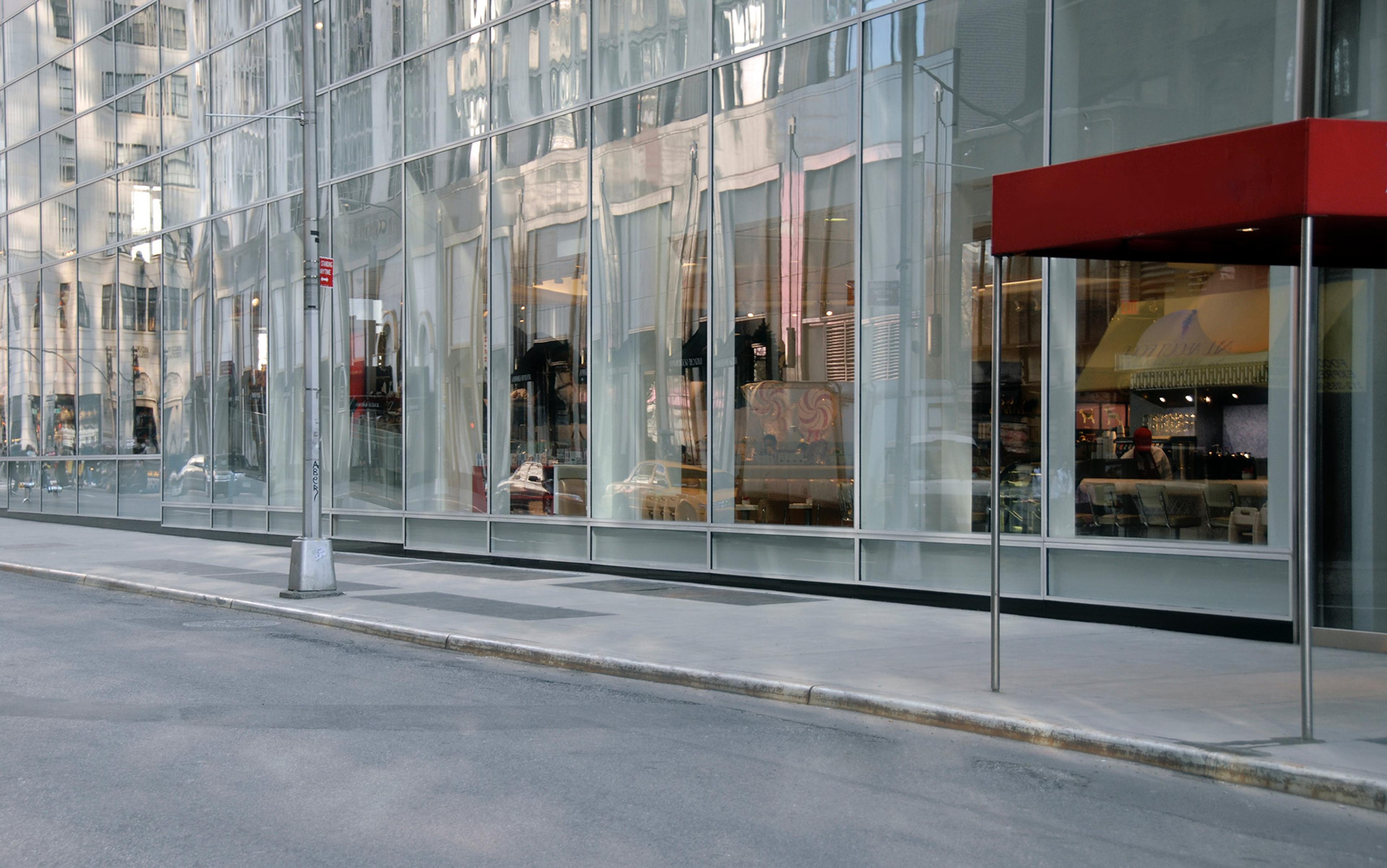In 2007, the Whole Foods supermarket chain built one of their largest stores on New York City’s storied Lower East Side, occupying an entire block of East Houston Street from the Bowery to Chrystie Street. For the well-off, the abundant availability of high-quality organic foods was a welcome addition, but for the majority of locals, many of whom had roots going back generations to New York’s immigrant beginnings, the scale of the new store, selling wares that few of them could easily afford, was a symbolic affront to the traditions of this part of the city.
When I conducted research at the site in 2011, my interest was more pedestrian: how did this megastructure – plopped into a neighbourhood populated with tiny bars and restaurants, bodegas, pocket parks, playgrounds and many different styles of housing – influence the psychological state of the urban pedestrian? What happens inside the minds of city-dwellers who turn out of tiny, historic restaurants with bellies full of delicious knish and encounter nothing but empty sidewalk beneath their feet, a long bank of frosted glass on one side, and a steady stream of honking taxicabs on the other?
To find the answer, I led small groups from site to site and had them answer questions that assessed their emotional state via a smartphone. At the same time, I had participants wear bracelets that measured their skin conductance – a simple but reliable window into their alertness, readiness to act, pay attention or respond to threat.
One of the sites in the study was midway along the long, blank façade of Whole Foods Market. A second site was a few steps away, in front of a small but lively strip of restaurants and stores with lots of open doors and windows, a happy hubbub of eating and drinking and a pleasantly meandering mob of pedestrians.
Some of the results were predictable. When planted in front of Whole Foods, my participants stood awkwardly, casting around for something of interest to latch on to and talk about. They assessed their emotional state as being on the wrong side of ‘happy’ and their state of arousal was close to bottoming out. The physiological instruments strapped to their arms showed a similar pattern. These people were bored and unhappy. When asked to describe the site, words such as bland, monotonous and passionless rose to the top of the charts.
In contrast, people standing at the other test site, less than a block away from Whole Foods, felt lively and engaged. Their own assessments of their states of arousal and affect were high and positive. The words that sprang to their minds were mixed, lively, busy, socialising and eating. Even though this site was so crowded with pedestrians that our participants struggled to find a quiet place to reflect on our questions, there was no doubt that this location was to their liking on many levels. In fact, even though we didn’t have the equipment to measure such things effectively, we could read the telltale signs of happiness or misery on our participants’ bodies as they worked to complete the study. In front of the blank façade, people were quiet, stooped and passive. At the livelier site, they were animated and chatty, and we had some difficulty reining in their enthusiasm. Our experimental protocol, requiring that participants not talk to one another while recording their responses, quickly went by the wayside. Many expressed a desire to leave the tour and simply join in the fun of the place.
Behavioural effects of city street design have been reported before. In 2006, the Danish urbanist Jan Gehl observed that people walk more quickly in front of blank façades; compared with an open, active façade, people are less likely to pause or even turn their heads in such locations. They simply bear down and try to get through the unpleasant monotony of the street until they emerge on the other side, hopefully to find something more interesting.
For planners concerned with making city streets more amenable and pedestrian-friendly, findings such as these have enormous implications: by simply changing the appearance and physical structure of a building’s bottom three metres, they can exert a dramatic impact on the manner in which a city is used. Not only are people more likely to walk around in cityscapes with open and lively façades, but the kinds of things that they do in such places actually change. They pause, look around and absorb their surroundings while in a pleasant state of positive affect and with a lively, attentive nervous system. Because of these kinds of influences, they actually want to be there. And because of such effects, many cities have carefully designed building codes for new construction that dictate some of the contributing factors to happy and lively façades: in cities such as Stockholm, Melbourne and Amsterdam, building codes specify that new construction cannot simply be parachuted into place. There is a hard lower limit on the number of doorways per unit of sidewalk length, and there are specifications for transparency between the building and street in the form of clear windows with two-way views.
In Gehl’s terms, a good city street should be designed so that the average walker, moving at a rate of about 5km per hour, sees an interesting new site about once every five seconds. This does not happen in front of Whole Foods in East Houston Street, nor outside any of the other large, monolithic structures such as banks, courthouses and business towers in cities throughout the world.
If city streets are designed with endless closed façades, such as those seen in supermarkets and bank headquarters, people might feel a little less happy and they might walk faster and pause less. But what is really at stake here? The real risks of bad design might lie less in unhappy streets filled with unmotivated pedestrians, and more in the amassing of a population of urban citizens with epidemic levels of boredom.
Boredom research has, on the whole, been conducted by individuals who were especially repulsed by the feeling. William James, one of the founders of modern psychology, wrote in 1890 that ‘stimulation is the indispensable requisite for pleasure in an experience’. In more recent times, serious discussion and measurement of states of boredom and stimulation began with the work of the late University of Toronto psychologist Daniel Berlyne, who argued that much of our behaviour is motivated by curiosity alone: the need to slake our incessant thirst for the new.
To make his case for information-seeking as a prime motivator of human behaviour, Berlyne turned to a branch of applied mathematics known as information theory. This powerful set of ideas, born in the laboratories of the Bell Telephone Company in the 1940s, was designed to help understand the transmission of signals through wires. The unit of information was described as the bit, which could either be zero, containing no information, or one, filled with information. One of the keys to the theory is that elements that don’t occur very often provide more information than those that occur commonly. Imagine you retrieve a garbled message from your voicemail, and can make out only certain words. If you heard the message: ‘… the … to … and … you …,’ you would learn very little; the bit value of the utterance would be very low. But if you heard: ‘I’m … way … dinner … call … later,’ you could do a good job of disentangling at least a part of the meaning. In terms of information theory, both utterances contain the same number of words. The difference is that the first contains only words that appear with high frequency in English, and carry few bits of information, while the second message contains words with lower frequencies (hence lower probabilities of occurrence), and more information.
Though it might seem like a stretch, there is in fact a connection between the technicalities of phone transmission and an understanding of urban psychology. According to Berlyne, it wasn’t just signals sent along wires that could be characterised in terms of their information content, but any kind of object that we can perceive, including visual displays such as pictures, three-dimensional objects, even streetscapes.
Now the reason for the dismal recordings of happiness and arousal in participants standing in front of blank façades should be clearer. At a psychological level, these constructions fail us because we are biologically disposed to favour locations defined by complexity, interest, and the passing of messages of one kind or another.
The opposite of this situation translates, essentially, to boredom. Though we might not all agree on a precise definition of boredom, some of the signs are well-known: an inflated sense of the inexorably slow passage of time; a kind of restlessness that can manifest as both an unpleasant and aversive inner mental state but also with overt bodily symptoms: fidgeting; postural adjustment; restless gaze; perhaps yawning.
It might seem extreme to say that a brief encounter with a boring building could be seriously hazardous to one’s health, but what about the cumulative effects of immersion?
Some researchers have suggested that boredom is characterised (perhaps even defined by) a state of low arousal. In some studies, it seems that when people are asked to sit quietly without doing anything in particular – presumably a trigger for boredom – physiological arousal appears to decrease. But Berlyne, and recently others, have suggested that boredom can sometimes be accompanied by high states of arousal and perhaps even stress.
In recent research conducted by the cognitive neuroscientist James Danckert of the University of Waterloo, in collaboration with his student Colleen Merrifield, participants were brought to the laboratory, hooked up to equipment that measured their heart rates and their skin conductance, and asked to watch some videos. The videos were carefully calibrated to elicit certain emotional states. In one, designed to elicit sadness, a heartrending scene from the movie The Champ (1979) was shown. Another video, designed to elicit boredom, showed two men passing clothespins to one another and hanging laundry on a line. Not surprisingly, the participants self-reported being saddened by the clip from The Champ and bored (or confused) by the laundry video. What was more interesting was that participants contributed saliva samples that were later analysed for the presence of cortisol, a hormone associated with a range of human stress-related ailments including stroke, heart disease and diabetes. The researchers discovered that even brief boring episodes increased levels of cortisol, which fits well with other recent suggestions that there could actually be a relationship between boredom and mortality rates.
Boredom can also lead to risky behaviour. Surveys among people with addictions, including substance and gambling addictions, suggest that their levels of boredom are generally higher, and that episodes of boredom are one of the most common predictors of relapse or risky behaviour.
Merrifield and Danckert suggest that exposure to even a brief, boring experience is sufficient to change the brain and body’s chemistry in such a way as to generate stress. It might seem extreme to say that a brief encounter with a boring building could be seriously hazardous to one’s health, but what about the cumulative effects of immersion, day after day, in the same oppressively dull surroundings?
This question has long interested psychologists, especially after the Canadian psychologist Donald Hebb’s discovery in 1962 that rats who lived in enriched, more stimulating environments were markedly superior intellectual beings to laboratory rats living in more spartan surroundings. Hebb’s enriched rats could solve more complicated maze problems in shorter times than their less-fortunate labmates. Later work carried out by the psychologist Mark Rosenzweig at the University of California at Berkeley showed that such enriched rats were not only superior performers, they also had a thicker neocortex with more richly developed synaptic connections between brain cells. The brain mechanisms responsible for the enrichment effects discovered by Hebb, Rosenzweig and many other researchers are so fundamental that it would be extraordinary if these principles did not apply to us as well.
Collectively, studies of both extreme and moderate forms of environmental deprivation provide compelling evidence that boring environments can generate stress, impulsivity, lowered levels of positive affect, and risky behaviour. At this point, we simply don’t know the extent to which such effects might be produced by simple daily exposure to poorly designed urban environments or building interiors because the studies have not yet been done. However, based on well-understood principles of neuroplasticity and on what is known of the effects of deprivation and enrichment in other more extreme settings, along with studies such as those conducted by Gehl and by my research group in several cities worldwide, there is every reason to believe that these sterile, homogeneous environments are exerting a measurable effect on our behaviour, and likely our brains as well. Given this, the prudent design of city streets and buildings is a matter of public health.
Why would anyone think it a good idea to build a large, featureless building at ground level? What motivates a developer to erect an endless stretch of suburban housing where each individual unit is identical and, in the language of information theory, low in entropy?
One obvious part of the equation, especially for suburban developments, is the economic one. It’s much less expensive to design only three or four different models of houses.
But what about our larger institutional buildings? Why build a closed, ground-level façade that will bore passersby? Perhaps the owners of such properties don’t see much to gain: it hardly seems in the best interests of a major bank to attract a crowd of happy lingerers to the fronts of their buildings, rather than serious customers who get in and get out again. A friendly façade might also be less in keeping with the image that the business wants to portray. We might want the bank looking after our assets to be a quiet, brooding, impenetrable fortress, rather than part of a whimsical and lively street market.
Human beings have evolved to operate in environments with optimal levels of complexity related to our biology. We seek out such settings with our eyes, our bodies, our hands and our feet
There are other reasons why buildings fall short of our psychological needs. One has to do with a radical shift in architectural design, in which entire buildings became signs. Think of a McDonald’s restaurant, which we can instantly recognise from a distance on the road, driving at high speed.
Another factor is our increasing reliance on digital technologies, which has shifted the focus of human attention palpably downward into the upturned faces of our phones and away from our physical surroundings. This problem has become so acute that, when she was New York’s transportation planner, Janette Sadik-Khan ordered large, attention-catching graphics to be painted onto the sidewalk at the city’s busiest and most dangerous intersections, to remind distracted pedestrians to look up from their devices to avoid impact with oncoming vehicles. Though this new behaviour of ours might seem nothing more than a simple change in posture and gaze, it is also symptomatic of more profound change: perhaps we no longer care as much about our surroundings because we no longer pay attention to them as we used to. In a very real sense, we are no longer there as we used to be, and our physical surroundings are no longer as real as they used to be.
The trend toward hybridisation of real and virtual spaces in urban environments has ideological roots. In their opus S, M, L, XL (1995), the Dutch architect Rem Koolhaas and the Canadian designer Bruce Mau argue for empty-box designs and what they call ‘the generic city’. They contend that any kind of architectural ornament, be it a particular kind of façade design, the idiosyncratic arrangement of streets, or specific elements of cultural iconography, is destined to be, in some sense, exclusionary. In a world in which we are being thrown together into groups that transcend old cultural borders, any kind of design with historic associations will alienate people who don’t share the same histories. In an interview published in 2011 in the German weekly magazine Der Spiegel, Koolhaas says that: ‘In an age of mass immigration, a mass similarity of cities might just be inevitable.’ Cities such as Dubai, where the majority of residents are immigrants, ‘function like airports in which the same shops are always in the same places. Everything is defined by function, and nothing by history. This can also be liberating.’
Koolhaas might be right about the inevitability of generic, functional design in an age of globalisation. But unless our electronic connections can supplant our physical surroundings, the widespread adoption of global, functional designs will have psychological consequences of the kind described here. Human beings have evolved to operate in environments with optimal levels of complexity related to our biology. We seek out such settings with our eyes, our bodies, our hands and our feet. In turn, the design and appearance of those settings, by affecting our bodies, tap directly into ancient circuits meant to produce responses and emotions that are adaptive. Very little of this is cultural. Such settings attune us to our surroundings, help us to maintain preferable states of arousal and alertness, and ultimately permit us to adapt. In a generic design, where our transactions with surroundings are artificially mediated using embedded intelligence and carefully designed interfaces that simulate the environmental contingencies for which we evolved, it might be possible for us to produce the perfect human environment. But it seems more likely that we will get enough things wrong that we will be worse off than ever before.
As much as we might like it otherwise, boredom is an inevitable element of modern life. One might even argue that some boredom is healthy. When the external world fails to engage our attention, we can turn inward and focus on inner, mental landscapes. Boredom, it has sometimes been argued, leads us toward creativity as we use our native wit and intelligence to hack dull environments. But streetscapes and buildings that ignore our need for sensory variety cut against the grain of ancient evolutionary impulses for novelty and will likely not lead to comfort, happiness or optimal functionality for future human populations.
Adapted from ‘Places of the Heart’ © 2015 by Colin Ellard, published by Bellevue Literary Press on 15 September 2015.






